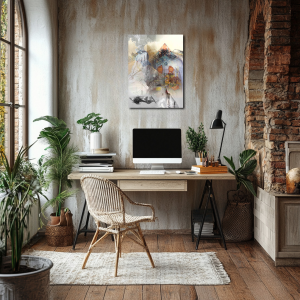Whispers Beneath the Mask: Frida’s Silent Dialogues with Death
Whispers Beneath the Mask reimagines Frida Kahlo’s Girl with Death Mask as a spectral dreamscape where childhood innocence meets the soft, inevitable truth of mortality. Through cracked ochres, ghostly lavenders, vibrant scarlets, and fading turquoise, the piece unfolds a universe where death blooms quietly alongside life. Anchored by the solemn girl and surrounded by mourning spirits, it honors the bittersweet beauty of recognizing that from our first breath, we carry death not as a terror, but as a silent, faithful companion.
Please see Below for Details…
Hotline Order:
Mon - Fri: 07AM - 06PM
404-872-4663
This conceptual reimagining of Frida Kahlo’s Girl with Death Mask transforms her chilling meditation on innocence and mortality into a spectral dreamscape where life’s first steps are shadowed by the soft, inevitable hand of death. Titled Whispers Beneath the Mask , the piece expands Kahlo’s raw confrontation between childhood and the spectral into a layered universe where masks dissolve, skin cracks, and death blooms with an unsettling tenderness.
At the center stands the small, vulnerable figure of the girl in the simple orange dress, her skull mask oversized and awkward against her tiny frame. In this reimagining, she is no longer isolated in a barren landscape but surrounded by swirling apparitions of women—ghostly figures adorned in vibrant Día de los Muertos paint, their faces cracked like ancient porcelain, their bodies fading into floral mists. These women do not threaten; they seem to mourn, to witness, to gently guide, holding within their hollowed gazes the secret knowledge the girl is only beginning to glimpse.
Surrounding them, floating between the visible and the invisible, are twin skulls wrapped in blossoms and vines, stitched into the soft folds of the ether. Their presence suggests that death is not simply an end but a constant, whispering companion—woven into the air, the flowers, the very act of breathing. In this world, death is not something that suddenly arrives; it is something that has always been here, walking beside us from the first gasp of life.
Color in Whispers Beneath the Mask hums with a delicate, mournful symphony. The lower sections of the piece are built on dusky earth tones: muted browns, cracked ochres, and fading saffrons. These colors ground the girl in a dream of decay, suggesting that innocence itself is rooted in fragile soil. Her dress, once bright, is rendered in a worn, burnished orange—a color that pulses with the final warmth of twilight before slipping into darkness.
The surrounding atmosphere shimmers with misty lavenders, bruised pinks, and ghostly creams, blending the tangible and intangible into a twilight fog. These spectral hues bleed into one another, creating a sensation of drifting between worlds, of slipping softly from childhood certainty into adult reckoning. The faces of the painted women glow with soft violets and melancholy blues, colors often associated with both mourning and transcendence, suggesting that even grief has its own strange, tender beauty.
The skulls themselves blaze with high contrast—ivory whites and velvet blacks interlaced with intricate floral patterns of scarlet, indigo, and gold. These vivid markings do not sanitize death; they celebrate its inevitability, wrapping its harshness in the vibrant language of culture and ritual. In this reimagining, death wears flowers not to conceal itself, but to remind the living that even endings can be beautiful when accepted without fear.
Soft bursts of magenta and pale turquoise flicker across the background, whispering of fleeting joys and the brief glimmer of life against the vastness of the unknown. These colors lend the piece a bittersweet luminescence, a faint echo of laughter and light even as the masks crack and dissolve into the gathering dusk.
When I created Whispers Beneath the Mask , I wanted to capture the strange, necessary collision that Frida Kahlo articulated so profoundly—the moment when a child first senses the shape of mortality pressing at the edges of the world. In her original Girl with Death Mask , Kahlo painted that moment with brutal, unblinking honesty. Here, I sought to stretch that fleeting recognition into an entire landscape, peopled with silent guardians who have long carried the knowledge the child is only beginning to bear.
The compositional rhythm spirals outward: the girl’s small, solemn form anchors the piece, while above her, the swirling faces and blooming skulls stretch upward and outward into the fading sky. The movement suggests both ascent and dissolution, reflecting the human journey through life—rooted in innocence, reaching toward understanding, and finally dissolving into memory and myth.
In this vision, the mask is no longer simply a costume; it becomes a living bridge between worlds. Behind it, the girl’s unseen face still yearns, still hopes, still fears. Yet around her, the ancient witnesses assure that to wear death’s mask is not to surrender to despair, but to recognize that love, memory, and spirit endure far beyond the body’s fragile life.
Add your review
Your email address will not be published. Required fields are marked *
Please login to write review!
Looks like there are no reviews yet.








